Even if you've never heard of a QR code, chances are that you're already subconsciously familiar with them. QR codes are used throughout a range of different marketing materials these days and over the last few years, they've become more common than ever.
A lot of our clients here at FastPrint.co.uk have been incorporating QR codes into their marketing materials for the last few years. We regularly incorporate them into their business cards, posters, flyers and even banners on behalf of our clients as we know just how powerful they can be when used correctly.
Despite this though, a lot of our clients still aren't entirely sure as to what a QR code actually is. We find ourselves regularly being asked what a QR code looks like, what they do and how they work.
Explaining this to every client can be quite a lengthy process so we thought we'd create this simple guide to explain exactly what a QR code is and how it works in plain English.
What Is A QR Code?
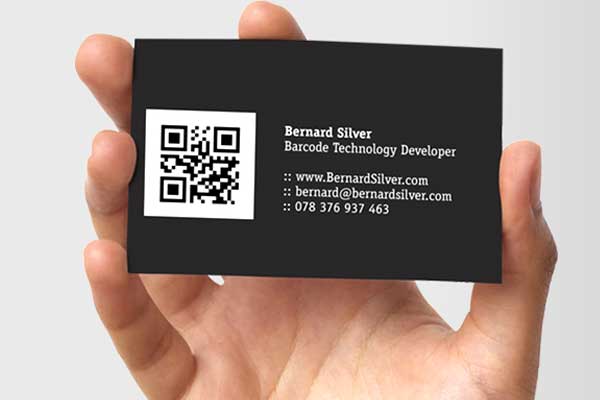
Source: Moo.com
If you take a look at the image of the business card above, you'll notice that on the left-hand side of the card, there is a strange graphic consisting of black squares and dots. This, essentially, is what a QR code looks like.
The idea behind a QR code is to create an image that can be scanned by any modern day Smartphone (with a QR code reader application) and translated into something more meaningful. QR codes are often used to contain web address information and links, but they can be used to direct Smartphone users to a multitude of other media too (e.g. videos, images etc).
Obviously, that's all well and good, but what actually is the point of a QR code? Surely you can just type in a web address on your phone and visit the website that way? While that may be true, the point of a QR code is to simplify the process. Smartphone (or tablet PC) keyboards are tricky compared to desktop/laptop keyboards and most of the time, people simply can't be bothered to type in website addresses on their Smartphone.
A QR code is used by marketers to simplify the process and therefore, entice more people into visiting a website or a piece of content. This is why marketers regularly place QR codes on banners, business cards, flyers, leaflets, posters and so forth.
How Does A QR Code Work?
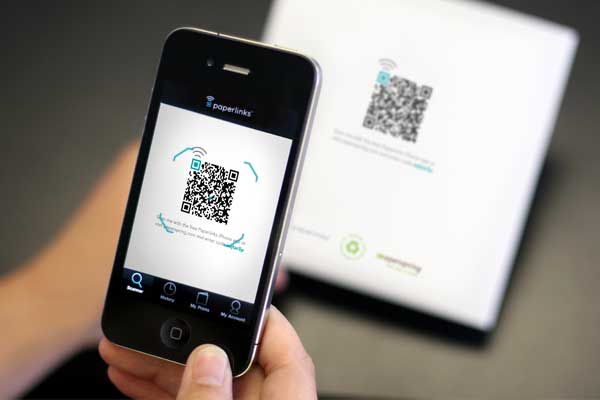
Source: BetaKit.com
Basically, a QR code works in the same way as a barcode at the supermarket. It is a machine-scannable image that can instantly be read using a Smartphone camera. Every QR code consists of a number of black squares and dots which represent certain pieces of information. When your Smartphone scans this code, it translate that information into something that can be easily understand by humans.
Quite simply, a QR code is an encoded piece of data. The data in a QR code can be alphanumeric, numeric, binary or Kanji (Kanji is a form of Chinese characters that are used in the modern Japanese writing system)
Although that is the technical explanation of how a QR code works, something much more important to focus on is the fact that QR codes can be scanned at the touch of a button by the hundreds of millions of people around the world that use a Smartphone on a daily basis. This makes them great for marketers.
If you've ever scanned a QR code with your Smartphone, you'll likely have noticed that they can be scanned extremely quickly (we're talking within a second-or-two here). This makes QR codes an extremely simple way to access stored information in an instant which in-turn, makes them a perfect solution to conversion-hungry marketers.
How Do You Create A QR Code?
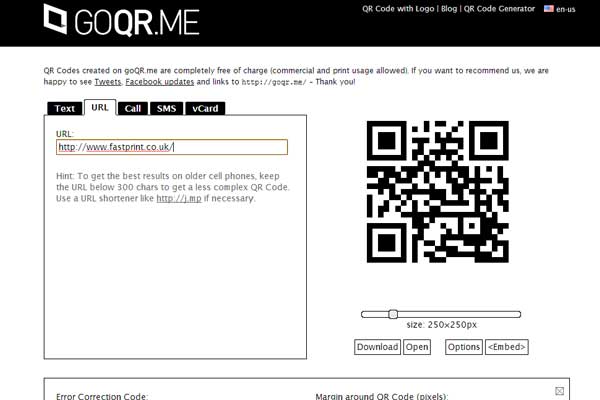
Source: GOQR.me
At this point, you might be sold on the idea of using a QR code in your marketing materials but you're probably thinking to yourself, how on earth am I going to create one of those? Luckily, you don't need to teach yourself the 'QR code language' as there are a plethora of online QR code generators just waiting to be used. These make the entire QR code generation process extremely straightforward.
One of our favourite QR code generators is GOQR.me as it's both functional and easy to use. To use a QR code generator, all you have to do is enter the text, URL, phone number, SMS or vCard information that you want to be scannable. The website will do the rest of the work for you and in seconds, it will have created a fully functional QR code for you. On GOQR.me, you have the option to download or embed the QR code with just the click of a button.
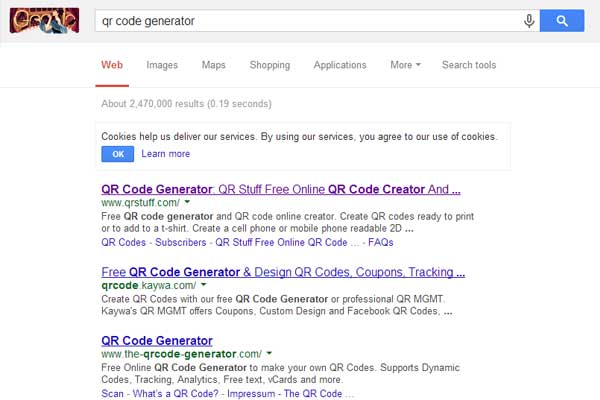
Source: Google
Note: There are plenty of other online QR code generators, just Google (or Bing) the phrase 'QR code generator' and you'll likely be confronted will millions of results. Just pick your favourite.
A lot of people don't realise this but you're not actually bound to using a boring black and white QR code image. In fact, once you have your basic QR created, you can edit the colours, graphics and a plethora of other things to make a truly unique design.
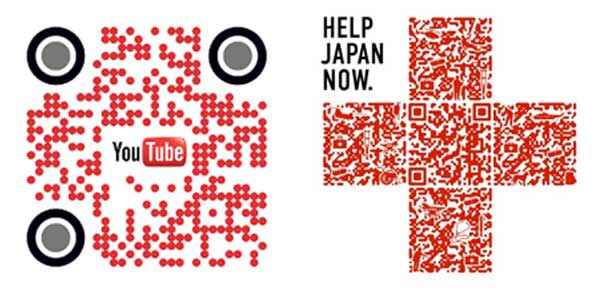
Source: Mashable & Unitaglive
Take a look at the two QR code designs above for example. You can see that these are a far-cry from the boring black and white bog-standard QR code designs that are created by most of the online generators. But how exactly do you create a design like this and still ensure that your QR code is readable/scannable?
What You Can't Change
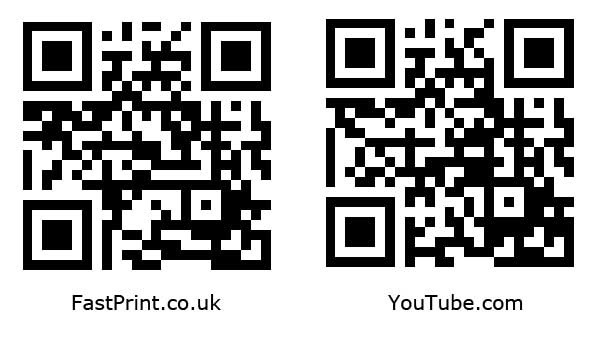
Before we talk about the areas of your QR code that you can change and get creative with, we're going to talk about the parts that must always remain unedited.
If you look at the two QR codes above (one for our own website and one for youtube.com), you'll notice that they look relatively similar. If you look closely though, you'll notice that there's only certain aspects of the QR codes that look similar and that many of the smaller black dots vary depending on the data that's been encrypted.
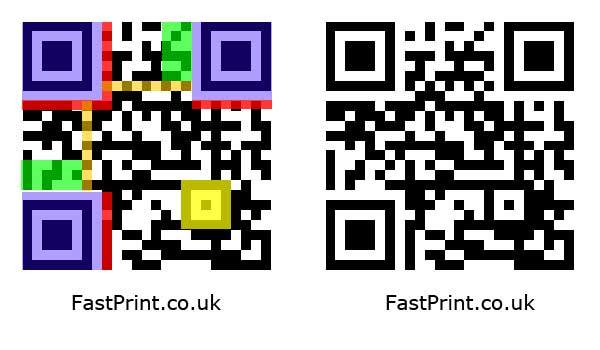
Source: N/A
Above, you can see a colour coded version of our own fastprint.co.uk QR code. The highlighted areas show various parts of the QR code that cannot be changed. An explanation of each area is below:
Blue: The three squares in the corners of the QR code that have been highlighted blue will be present on every QR code you come across. These are essentially position markers and their job is to tell the scanner where the edges of the QR code are.
Orange Strips: The two orange strips show alternating black and white dots (much like a zebra-crossing). The job of these strips is to tell the scanner where the columns and rows of black and white dots are placed. They go by the name of timing patterns.
Red: The red areas of the QR code tell the scanner what type of information will be encoded (e.g. a website URL, SMS message, vCard information, alphanumeric, numeric and so forth).
Green: The green areas represent the version number of the QR code. These are used on QR codes with version numbers ranging from 6 to 40. If the version of your QR code is under 6, the scanner doesn't need to have the version defined as it will be able to work it out from the individual areas of the QR code.
Yellow Square: The yellow square is also a constant part of every QR code as it acts as an alignment marker. In some larger QR codes, you might see a few of these as the scanner uses more to ensure a more accurate alignment.
What You Can Change
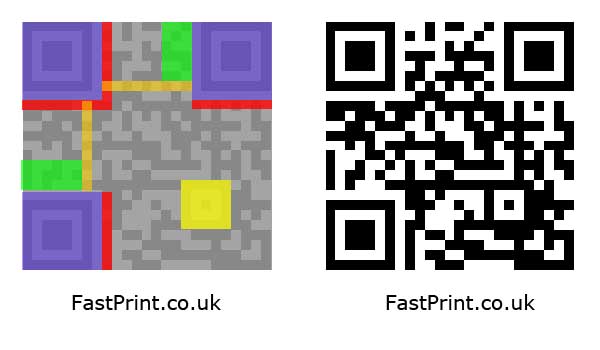
Source: N/A
At this point, you might be thinking that you can change every part of the QR code aside from the sections mentioned above. If you are thinking this, you're both right and wrong.
The remaining area of the QR code is split into different sections (called modules). Each module consists of eight black/white squares grouped together (the best way to think of these is like bytes).
When a QR scanner is scanning a QR code, it actually scans these modules independently. This means that if one of the eight squares (or bytes) in the module happens to be covered up, the scanner will render the entire module as 'unreadable'.
This might sound pretty terrible, but it actually isn't a problem thanks to something called the Reed Solomon error correction method.
How The Reed Solomon Error Correction Method Works
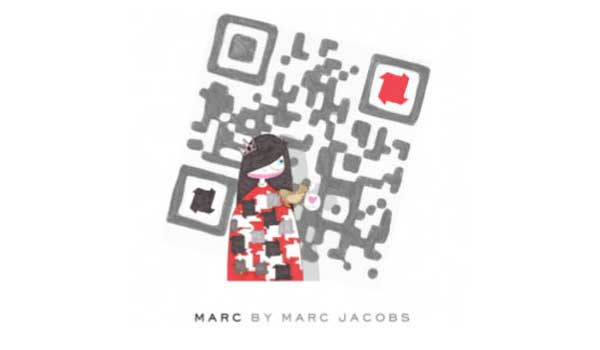
Source: ShiftEast.com
If you happen to have checked out that Wikipedia link above, you'll likely have been confused by the plethora of mathematical formulas that you were presented with. So let's explain in plain English how the correction method works.
Take a look at the QR code pictured above. This was created by the well-known brand, Marc Jacobs and believe it or not, it is actually a fully functioning QR code (despite the girl covering up half of the design). This is all thanks to the Reed Solomon Correction Method.
Basically, the Reed Solomon method is an algorithm that all QR code readers have built-in as standard. It allows QR codes to be scanned even if a certain amount of the QR code is covered up or blocked.
However, there is a limit as to how much of your QR code you can cover up. The Reed Solomon method isn't magic, but it does do a good job of filling in the blanks so long as you adhere to the basic principles.
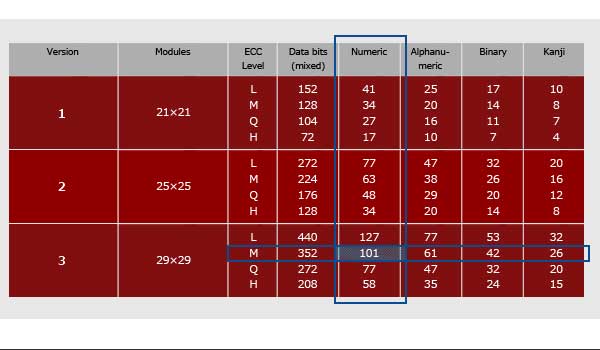
Source: QRcode.com
As there are different versions and sizes of QR codes, the amount you can cover up or alter will vary depending on a number of factors. The easiest way to figure out how much of the QR code can be covered up is to use the table located on the QRcode.com website.
To use this, you need to browse the table and find the sort of QR code that you are using. To do this, you'll need to know the version of your QR code and also, the number of characters that the 'mess' within the QR code actually contains (e.g. if your QR code was the URL http://www.fastprint.co.uk/ - there would be 27 characters). The table will then give you a letter that corresponds with your QR code.
Here are the letters and their meanings:
Letter H: If your QR code is given a letter 'H' code, you'll be able to cover up or alter as much as 30% of the code (i.e. if you have 120 dots/bytes, you'll be able to cover up around 36 of them).
Letter Q: You'll be able to alter up to around 25% of your code (i.e. if you have 120 dots/bytes, you'll be able to cover up around 30 of them)
Letter M: You'll be able to alter up to around 15% of your code (i.e. if you have 120 dots/bytes, you'll be able to cover up around 18 of them)
Letter L: You'll be able to alter up to around 7% of your code (i.e. if you have 120 dots/bytes, you'll be able to cover up around 8 - 9 of them)
You should keep in mind that this is only a rough guide, so constant testing of your QR code is a must.
Conclusion
We hope we've managed to shed some light on QR codes and how they work but if you do have any other questions, please don't hesitate to give us a call, we're always happy to help.
Creating QR codes is pretty straightforward if you only want to create a basic design but if you're looking to create a fully customised QR code, things can often get complicated. It's usually a good idea to leave this to an experienced graphic designer with knowledge of QR codes if possible.